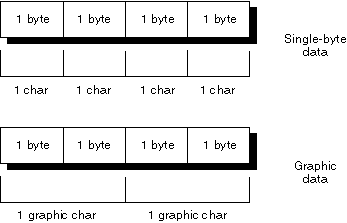
The graphic format is a character string where each character is represented by 2 bytes.
Fields defined as graphic data do not contain shift-out (SO) or shift-in (SI) characters. The difference between single byte character and double byte graphic data is shown in the following figure:

The length of a graphic field, in bytes, is two times the number of graphic characters in the field.
The fixed-length graphic format is a character string with a set length where each character is represented by 2 bytes.
For information on the variable-length graphic format, see Variable-Length Character, Graphic and UCS-2 Formats.
You define a graphic field by specifying G in the Data-Type entry of the appropriate specification. You can also define one using the LIKE keyword on the definition specification where the parameter is a graphic field.
The default initialization value for graphic data is X'4040'. The value of *HIVAL is X'FFFF', and the value of *LOVAL is X'0000'.